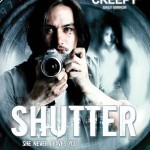 Shutter is a horror film made in Thailand, in 2004. It is clearly inspired by the wave of horror films, coming predominately from Japan, that have come to be known as J-Horror.
Shutter is a horror film made in Thailand, in 2004. It is clearly inspired by the wave of horror films, coming predominately from Japan, that have come to be known as J-Horror.
After a night out drinking with friends, our main characters Tun and Jane are driving home when their car hits a woman. Freaking out, Tun insists that they not get out of the car and just head home. After the accident Tun, who works as a photographer, starts finding strange images in the pictures he takes. This leads him, and Jane, to start learning about the phenomena of ghost photos.
As the haunting escalates beyond the photos, invading their lives, Tun and Jane attempt to learn exactly whom they had hit, and what really happened. Things get more desperate when they learn that the friends with whom they had been out drinking have also been having strange encounters, and that two of them have died.
As the mystery unfolds, we learn that there was more going on than a simple hit and run, and that the ghost may have an honest grievance against those she is targeting.
Shutter is a masterfully made horror film. The directing and writing team of Bangjong Pisanthankun and Parkpoom Wongpoom have a clear understanding of how to pace the film, which is where so many horror films fail. The tension is built expertly throughout the film and, unlike so many horror films, does not switch to action movie pacing during the third act.
Their writing is also top notch. They set up a standard horror movie premise in the beginning, and then a series of twists wherein something else was going on all along. And while these twists are well done, they are not M. Night Shyamalan twists that happen at the end and seem to be the point of the whole movie. Instead they are well integrated into the script and make perfect sense once revealed.
The movie also integrates elements of several horror traditions. Clearly the main one is typical of J-Horror, with the angry female spirit seeking vengeance. You also have elements of standard EC horror comic plots, with someone who has been wronged, coming back from the grave to wreak their own brand of justice. There are even nods to Hitchcock in the film. But most importantly, all of these are subtle and do not detract from the story itself.
The acting is well done, especially by Ananda Everingham as Tun, and Natthaweeranuch Thongmee as Jane. Their reactions come off as authentic and believable.
The one element that really struck me, while watching the movie, was the cinematography. This is a movie that has photography as a major theme, and thus color and composition are going to be key to making that seem realistic. Cinematographer Niramon Ross does a brilliant job with this work, making this an important part of the story telling. It also ends with one of the most powerful and haunting images I can remember in recent horror.
I want to take a moment to talk about the jump scares. This is a pet peeve of mine in horror. I have nothing against a good jump scare; what I hate are false jump scares. The tension is built, the jump scare happens, and it turns out to be the cat, which then immediately leads to the actual jump scare. This never happens in Shutter. Each jump scare is legitimately the ghost. There are even some rapid succession jump scares, but they are still always the ghost. To me this shows that the directors knew what they were doing, and trusted their material.
It is worth noting that Shutter has become a fairly influential film, with eight remakes (seven in other countries, including the U.S., and one in Thailand).
Using the Fanboy News Networking rating scale, I give Shutter a grade of B+. Horror fans will love it, and non-fans should at least feel that they did not waste their time. It is a must have for any horror fan’s DVD collection.
